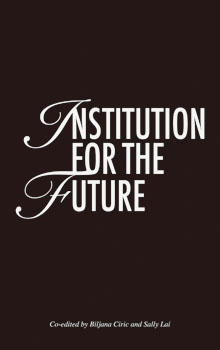The need to evolve our ways of working has always been necessary. In light of the drastic changes to the structure of the art world over the last decade and the wider socio-political and economic challenges we are facing the need to reconsider our modes of operating to find alternatives seems more pressing than ever. How might we see beyond the current and develop institutional models that function in an unknown future?
Through pondering what an institution for the future might look like the contributors explore a rich array of questions including what the relationship between an institution and artists should be, the possibilities for institutions and activism, an institution’s frame of reference and how should it connect to local and international contexts, the role of an institution in research and knowledge production, an institutions relationship to the temporal as well as spatial and an institution as a way of being.
Contributions include drawings, critical texts, informal correspondence, found text, hypothetical proposals, interviews and diagrammatic explorations by:
- Ade Darmawan (ruangrupa)
- Alistair Hudson (Grizedale Arts)
- Dmitry Vilensky (chto delat?)
- Dorothea von Hantelmann
- Elaine W Ho
- Gerald Raunig
- Hans Ulrich Obrist
- Hu Xiangqian
- Ho Tzu Nyen
- Jens Hoffmann
- Joăo Ribas
- Jun Yang
- Keren Cytter
- Liu Ding
- Marina Abramović
- Michael Lee
- Monika Szewczyk
- Nikita Cai
- Richard Streitmatter-Tran
- Roslisham Ismail aka Ise
- Sam Bower (Green Museum)
- Seng Yujin
- Third Belgrade
- Tino Sehgal
- Vandy Rattana
- Yoko Ono
Edited by: Biljana Ciric and Sally Lai
Editorial adviser: Alexandra Hodby
Designed by: Lu Pingyuan and He Yiming
Language: English
Published by: Chinese Art Centre (www.chinese-arts-centre.org)
ISBN: 978-0-9545440-5-8
Distributed by Cornerhouse Publications (www.cornerhouse.org/books)
Supported by: Arts Council England, dia/projects, Ho Chi Minh City


